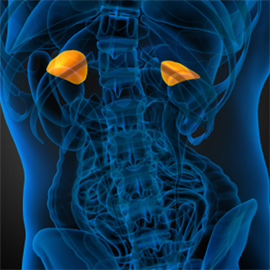Small study suggests that high cortisol level in hair may foretell hard-to-diagnose disorder

Analyzing a hair sample may help with the diagnosis of Cushing Syndrome, a rare and potentially fatal disorder in which the body overproduces the stress hormone cortisol, according to researchers at the National Institutes of Health.
Diagnosing Cushing Syndrome is often difficult and time-consuming, requiring 24 hours to analyze blood and urine tests, brain imaging tests, and tissue samples from sinuses at the base of the skull. The researchers found that measuring cortisol levels in hair samples tracked closely with standard techniques for diagnosing Cushing Syndrome.
"Our results are encouraging," said the study's senior author, Mihail Zilbermint, M.D., an endocrinologist at NIH's Eunice Kennedy Shriver National Institute of Child Health and Human Development (NICHD). "We are hopeful that hair analysis may ultimately prove useful as a less-invasive screening test for Cushing Syndrome or in helping to confirm the diagnosis."
The findings appear in Endocrine: International Journal of Basic and Clinical Endocrinology.
The high level of cortisol in Cushing Syndrome may result from a tumor of the pituitary or adrenal glands or as a side effect from certain medications. Cortisol is produced by the adrenal glands and helps to maintain blood pressure and heart function and to regulate blood sugar levels and the immune system. Symptoms of excess cortisol include obesity, high blood pressure, high blood sugar, high cholesterol levels, fatigue and depression. Although the condition can be cured, it can be fatal if it is not diagnosed and treated early
The researchers enrolled 30 patients with Cushing Syndrome and 6 patients who did not have the condition. The number of patients in the study was small, compared to studies of patients with more common disorders, because Cushing Syndrome is rare and it is difficult to recruit a large number of patients. Still, the researchers believe their study is the largest of its kind to compare hair cortisol levels to diagnostic tests in Cushing patients.
The study participants provided hair samples divided into three equal segments. Researchers observed that the hair segments closest (proximal) to the scalp had the most cortisol. Compared to hair segments furthest away from the scalp, the cortisol content of the proximal segments correlated closely with tests for cortisol levels in the urine and in blood taken at night. For most people, cortisol levels decrease at night. An elevated nighttime cortisol level in the blood is considered to be a key indicator of Cushing Syndrome.
The authors note that further studies are needed to confirm their findings.
Reference: Hodes A, et al. Hair cortisol in the evaluation of Cushing Syndrome. Endocrine: International Journal of Basic and Clinical Endocrinology.
###
About the Eunice Kennedy Shriver National Institute of Child Health and Human Development (NICHD): NICHD conducts and supports research in the United States and throughout the world on fetal, infant and child development; maternal, child and family health; reproductive biology and population issues; and medical rehabilitation. For more information, visit NICHD's website.
About the National Institutes of Health (NIH): NIH, the nation's medical research agency, includes 27 Institutes and Centers and is a component of the U.S. Department of Health and Human Services. NIH is the primary federal agency conducting and supporting basic, clinical, and translational medical research, and is investigating the causes, treatments, and cures for both common and rare diseases. For more information about NIH and its programs, visit www.nih.gov.

 BACK TO TOP
BACK TO TOP